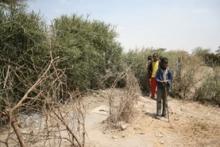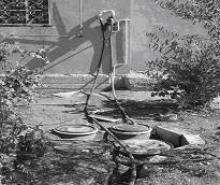Wastewater
Greywater reuse has potential for non-potable applications that conserve freshwater resources in water-stressed areas especially in sub-Saharan Africa. The feasibility of reusing greywater for domestic activities in a rural area of Malawi, Africa, was evaluated from microbiological and public acceptance perspectives. Median Escherichia coli concentrations for eight domestic greywater sources (handwashing, laundry, runoff from a tap apron, bathing, cleaning a home/kitchen, cleaning a water collection container, washing plates and soaking vegetables) ranged from 100 to >20,000 colony forming units (cfu)/100 ml. Twenty-four of 47 greywater samples tested (51%) met the World Health Organization guideline for unrestricted use of greywater for irrigation. Pertinently, 80% (4/5) and 60% (3/5) of greywater samples from handwashing stations and bathing had E. coli less than the WHO guideline. Users reported greatest acceptance of reusing greywater for growing food and washing clothes, especially when the greywater source was bathing. Acceptance was closely tied to a household’s economic standing, geographic location, and first-hand knowledge of reusing
greywater. Greywater reuse practices in rural areas, especially targeting bathing water as suitable from bacteriological and user perception criteria, can help mitigate the impacts of water stress in sub-Saharan Africa.
This case study focuses on the less documented faecal sludge reuse interventions in Ethiopia: Arborloo and Fossa Alterna, as implemented in East Arsi and Eastern Hararghe, in the Central Rift Valley, and in Arba Minch.
The case study is part of the MUStRAIN case study series in which the uptake of Multiple Use Services (MUS) in different contexts within Ethiopia is being documented. The case studies analyse cost-benefit relations as well as opportunities and challenges for implementation of MUS.
L. Raschid-Sally, D. Van Rooijen & E. Abraham: Analysing productive use of domestic water and wastewater for urban livelihoods of the poor – a study from Accra, Ghana.
Using Accra as an example, the paper records the different urban livelihood activities that utilize domestic water/wastewater, quantifies such use and presents a framework for planning multiple uses in an urban context. The paper provides insights to city planners, water authorities, and researchers on the wide range of ‘other uses’ that urban domestic water supply and wastewater is utilized for and how to quantify such use. From preliminary findings we conclude that the interests of people who use domestic water for livelihood purposes can be better accounted for under conditions of improved access, which will reduce the price they pay for water and increase their profit margin. The constraining factor for making productive use of water is not so much water shortage, as inequity of water access in the city. In the case of wastewater, managing the risk is essential for ensuring sustainability of these livelihoods. [authors abstract]
A powerpoint presented by Ann Thomas, International Development Research Centre (IDRC), in Delft, 2007, on health impacts of reuse of wastewater.
A powerpoint presented by Adriaan Mels, Okke Braadbaart, Jules van Lier and Grietje Zeeman, Lettinga Associates Foundation for Environmental Protection and Resource Conservation on how eco-sanitation relates to multiple uses of water.
A powerpoint presented by Stef Smits on a framework of linkages between sanitation, wastewater and livelihoods
This is the background note for the session on MUS, sanitation and reuse for the MUS Thematic Group Meeting, Delft, 12-13 Feb 2007.
The winning case study for the 2005 award was Laba Hari Budhathoki of NEWAH in Nepal. It described the broad benefits of an integrated water, sanitation and hygiene project that also included promotion of kitchen gardening. NEWAH used the award to undertake a follow-up study, and you can now read a full report on how gardening was promoted in the project, and the impacts.
A powerpoint presented by Mike Smith, Water, Engineering and Development Centre (WEDC) on household use of grey water, wastewater and rainwater.
INTRODUCTION
Water supply in Jordan is limited, and the lack of new water resources and the level of competition between different water uses like domestic, industrial and agricultural are expected to increase in the near future. Applied research conducted by the Inter-Islamic Network on Water Resources Development and Management (INWRDAM) on decentralized wastewater treatment and use over the last five years has focused on a holistic approach for the development of “state-of-the-art” modular on-site and low-cost greywater treatment and use units at the household level, and implementing capacity building of the local peri-urban communities to enable them to practice sustainable Urban Agriculture (UA). The research focused on optimization of the modular low-cost units for greywater treatment and drip irrigation techniques and crop selection for home gardens. These practises enable saving of freshwater and help safeguard the environment, increase income and strengthen the role of women in the process of proper management of scarce water resources.
Two projects, “Post Project Evaluation of Permaculture Techniques” and “Greywater Treatment and Reuse in HomeGardens” were conducted in the town of Ein Al-Baida, Tafila Governorate, in the southern part of Jordan funded by research grants from the International Development Research Centre, Ottawa, Canada (IDRC). A third project entitled “Community Involvement in Reuse of Greywater to Improve Agriculture Output” was financed by the Jordanian Ministry of Planning and International Cooperation of Jordan (MOPIC). This project benefited more than 800 households in 90 peri-urban sites throughout Jordan providing greywater treatment units and drip irrigation systems.
The aim of this case study is to concentrate on the methods and results of INWRDAM greywater treatment and use.
Technologies
On-site greywater treatment methods developed by INWRDAM were designed with low cost and ease of construction in mind as well as low operation and maintenance costs. They aim to yield greywater of a quality suitable at least for restricted irrigation.
The 4-barrel system
This system is an improvement of the two barrel kit. Two tanks each with 220 liter capacity and filled with gravel media that act as anaerobic filters are inserted between the pre-treatment tank and final storage tanks. The four barrels are lined up next to the other and interconnected with 50 mm PVC pipes.
Once solids and floating material settle in the first barrel, the relatively clear water from the first barrel enters into the bottom of the second barrel. Next the water from the top of the second barrel enters into the bottom of the third barrel. This water passes through the gravel lumps (2-3 cm size graded gravel) and from the top of the third barrel is taken into the fourth. Anaerobic treatment is accomplished in the two middle barrels. Anaerobic bacteria get established on the stone surface so that when the greywater passes through the stones, the bacteria works on breaking down components of the organic material in the greywater. The last barrel acts as a storage tank for treated greywater. As soon as this barrel is filled, a floating device switches on a small water pump which then delivers the water through the drip irrigation network. For an average family home, 20-30 trees (olives, fruit etc) that are planted in the domestic garden can be irrigated.
With a residence time of 1 to 2 days in the 4- barrel treatment kit, the influent greywater undergoes treatment equivalent to between primary and secondary treatment and meets the World Health Organization’s guidelines for restricted irrigation.
The confined trench system
Two plastic barrels and a dug trench filled with gravel media constitute the confined trench system. The first barrel functions as a grease, oil and solids separator and thus acts as a pre-treatment or primary treatment chamber, where the solid matter from the influent greywater settles and the floating components such as grease and soap foam float and can be removed regularly. A trench is dug close to the first barrel with approximate dimensions of 3 meter length, 1 meter width and 1 meter depth. This is lined with an impermeable polyethylene sheet of 400-500 µm thickness. The trench is then filled with 2-3 cm size graded gravel. Pre-treated wastewater from the first barrel enters the bottom part of the trench from one side and follows slowly to the other end. The sides of the side trench are plastered with a mud layer so that the liner sheet is not punctured by sharp stones. A 120 liter capacity plastic barrel is perforated and buried in the gravel at each end of the trench so that treated wastewater flows throughout the trench and upwards to fill this barrel. As soon as this barrel is filled, a floating device switches on a small water pump which then delivers the water through the drip irrigation network. Residence time of greywater in the trench is 2-3 days under anaerobic conditions. The confined trench unit can serve more than one nearby family sharing the same garden plot and it also can deliver more water quantity between pumping cycles.
Results and discussion
This project resulted in many direct and indirect benefits to the community and the environment. Women in the community benefited most from this project through training workshops, dialogue and learning-by-doing and acquired new skills to build a productive garden. The monthly domestic water consumption decreased by about 30% for all greywater users and income of the poor increased on the average by US$50 to US$ 150 per month. Many beneficiaries no longer had to pay a large portion of their monthly income for emptying their septic tanks. Many families started to copy and imitate the practice of their neighbours with respect to greywater use.
INWRDAM has also succeeded in promoting similar greywater activities in other Islamic countries, such as Lebanon, where greywater reuse is being adopted in a cluster of six towns. More projects addressing grey water use are now being implemented in Jordan, Palestine and Lebanon with an emphasis on conserving fresh water, improvement of sanitation and generating extra income for the poor in peri-urban areas and promoting sustainable urban agriculture practices. A recent evaluation of INWRDAM greywater projects by an external evaluator indicated that: “INWRDAM has contributed to raising the profile of greywater use both in Jordan and in other parts of the world”.
Recommendations for further work
The following recommendations can be made regarding the appropriateness of greywater use technologies:
- The scheme or technology should be a felt priority in public or environmental health, and both centralized or de-centralized technologies should be considered
- technology should be low-cost and require low energy input and mechanization which reduces the risk of malfunction
- technology should be simple to operate, be locally labour intensive, be maintained by the community, and not rely on expensive chemical inputs such as chlorine or ozone to meet quality guidelines
- treatment should be capable of being incrementally upgraded as user demand or quality standards and treatment guidelines increase.
References
Bino, J. Murad and Al-Beiruti, S. Greywater Treatment And Reuse Project, Tafila, Jordan (2000-2003). Conducted by the Inter-Islamic Network on Water Resources Development and Management with financial support from the International Development Research Centre (IDRC).
Author
Shihab Al-Beiruti, Head of Services and Programs Section, The Inter-Islamic Network on Water Resources Development and Management (INWRDAM), PO Box 1460, Jubieha-Amman, 11941, JORDAN (shihabinw@nic.net.jo)


